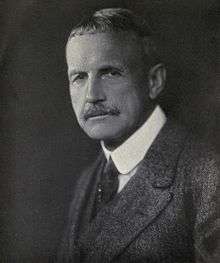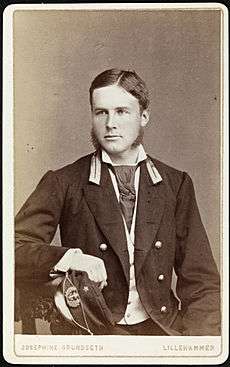Carl Sofus Lumholtz
| Carl Lumholtz | |
|---|---|
 | |
| Born |
Carl Sofus Lumholtz April 23, 1851 Fåberg, Norway |
| Died |
May 5, 1922 (aged 71) Saranac Lake, New York |
| Nationality | Norwegian |
| Fields |
Ethnography Adventure |
| Alma mater | University of Oslo |
|
Signature | |
Carl Sofus Lumholtz (23 April 1851 – 5 May 1922) was a Norwegian explorer and ethnographer, best known for his meticulous field research and ethnographic publications on indigenous cultures of Australia and Mexico.
Biography
Born in Fåberg, Norway, Lumholtz graduated in theology in 1876 from the Royal Frederick University, now the University of Oslo.
Lumholtz travelled to Australia in 1880, where he spent ten months from 1882-1883 amongst the indigenous inhabitants of the Herbert-Burdekin region in North Queensland. He wrote a book about his experience, Among Cannibals: An Account of Four Years' Travels in Australia and of Camp Life with the Aborigines of Queensland, first published in 1889, which is regarded as the finest ethnographic research of the period for the northern Queensland Aborigines.[1] Other anthropologists like Edward Bonney disregarded him because of his lack of respect for the Australian native people.

Whereas previous authors had commented only upon the aesthetic physical appearances and material culture of the region's indigenous people, Lumholtz added a level of academic research that was unique for the period. His work recorded for the first time the social relationships, attitudes and the role of women in the society. He also gave a series of two lectures on Among Australian Natives for the Lowell Institute for their 1889–90 season.[2]
He spent a total of four years in Queensland, his expeditions included visits to the Valley of Lagoons and the Herbert River area. He made collections of mammals while living with the local peoples, these specimens were used for the descriptions of four new species. One of these was named for the type locality, Pseudochirulus herbertensis (Herbert River Ringtail Possum), and another commemorates his name, Dendrolagus lumholtzii (Lumholtz's Tree Kangaroo).[3]

Lumholtz later travelled to Mexico with the Swedish botanist C. V. Hartman He stayed for many years, conducting several expeditions from 1890 through to 1910 which were paid for by the American Museum of Natural History. His work, Unknown Mexico, was a 1902 two-volume set describing many of the indigenous peoples of northwestern Mexico, including the Cora, Tepehuán, Pima Bajo, and especially the Tarahumara, among whom he lived for more than a year. Lumholtz was one of the first to describe artifacts from the ancient shaft tomb and the Purépecha culture. He described archaeological sites, as well as the flora and fauna, of the northern Sierra Madre region called the gran Chichimeca. He gave a series of three lectures on "The Characteristics of Cave Dwellers of the Sierra Madre" for the Lowell Institute's 1893-94 season.[2]
In 1905 Lumholtz was a founding member of the Explorers Club, an organization to promote exploration and scientific investigation in the field.[4] He went on a brief expedition to India from 1914–1915, then to Borneo from 1915 to 1917, which was his last expedition.
In 1922 Lumholtz died of tuberculosis at Saranac Lake, New York, where he was seeking treatment at a sanatorium. He had published six books on his discoveries, as well as the autobiography My Life of Exploration (1921).
Legacy and honors
His greatest legacy was his books and his way of working, which strongly influenced the field of ethnography.
- The Lumholtz National Park of North Queensland was named in his honor when created in 1994. However, the name was subsequently changed to Girringun National Park in 2003 to reflect its indigenous roots.
- The Mexican conifer Pinus lumholtzii, Lumholtz's pine, was named after him.
- The marsupial species Lumholtz's tree-kangaroo (Dendrolagus lumholtzi) was named after him.
Works
An incomplete list of works:
- Among Cannibals; an account of four years' travels in Australia and of camp life with the aborigines of Queensland (1889).
- Unknown Mexico; a record of five years' exploration among the tribes of the western Sierra Madre; in the tierra caliente of Tepic and Jalisco; and among the Tarascos of Michoacan (1902).
- Through Central Borneo; an account of two years' travel in the land of the head-hunters between the years 1913 and 1917 (1920).
- My life of exploration (1921).
Notes
- ↑ Brayshaw (1990)
- 1 2 Harriet Knight Smith, The history of the Lowell Institute, Boston: Lamson, Wolffe and Co., 1898.
- ↑ "Carl Sofus Lumholtz - biography". Biography. Australian National Herbarium. 17 December 2009. Retrieved 3 November 2010.
citing: J.W. Cribb, The Queensland Naturalist, Vol.44, Nos.1-3, 2006
- ↑ "About the Club: A Gathering Place". The Explorers Club: Promoting Exploration and Field Sciences Since 1904. Explorers Club. 2002. Archived from the original on 2008-07-19. Retrieved 2008-03-31.
References
- Brayshaw, Helen (1990). Well Beaten Paths: Aborigines of the Herbert/Burdekin District, North Queensland; An Ethnographic and Archaeological Study. Studies in North Queensland history, no. 10. Townsville, Qld: Department of History, James Cook University of North Queensland. ISBN 0-86443-322-0. OCLC 23267008.
- Cedano, Luis Romo (2002). "Carl Lumholtz y El México desconocido" (PDF). In Manuel Ferrer Muñoz (ed.). La imagen del México decimonónico de los visitantes extranjeros: ¿un estado-nación o un mosaico plurinacional? (PDF online facsimile). Serie Doctrina Jurídica, no. 56 (in Spanish). México D.F.: Instituto de Investigaciones de Jurídica, Universidad Nacional Autónoma de México. pp. 331–368. ISBN 968-36-9318-0. OCLC 50761138.
External links
| Wikimedia Commons has media related to Carl Lumholtz. |
- Works by Carl Lumholtz at Project Gutenberg
- Works by or about Carl Sofus Lumholtz at Internet Archive
- Works by or about Carl Sofus Lumholtz in libraries (WorldCat catalog)